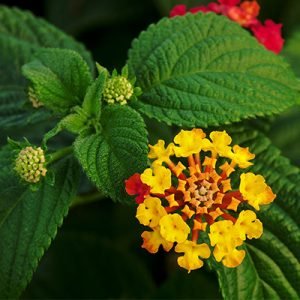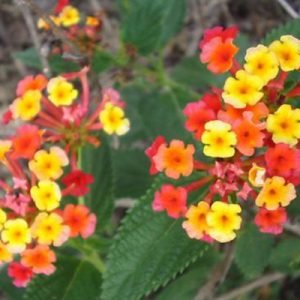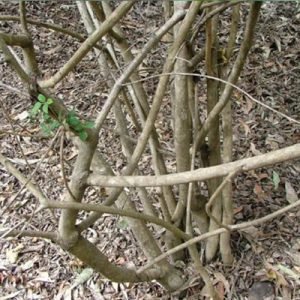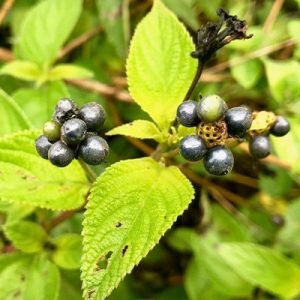Lantana Weed Control with The Razorback
Lantana - What is it and how can I control it?
Lantana is a weed of national significance in Australia growing around the coastal areas of all states, with most of the overgrowth along the Eastern Coast. Native to Mexico, Central America, Tropical South America and the Caribbean’s, Lantana was first introduced into a Sydney Garden in 1840 and has since spread rapidly across all states. If lantana is left alone it spreads and is hard to take control of.
What does Lantana look like?
Lantana is usually a dense shrub, and it can drop its leaves in dry times. It usually grows from 2 – 4m high but can scramble up into trees.
There are 5 main types with different flower colors: Pink, Red, Orange, White and Pink-edged Red, these flowers bloom almost all year round.
Red Lantana has pricklier stems and darker green leaves than Pink Lantana.
Stems are square with short, curved prickles.
The leaves are rough and bright green on top, hairy and pale green underneath with serrated edges opposite each other on the stem on a short stalk about 10 cm long 2 – 8 cm wide egg to spearhead-shaped.
Flowers are in clusters and different colors depending on the type of Lantana, age, and location.
The Berries that grow on the Latana, can vary in size from 6-8mm in diameter. In the early stages, the Berries will be green and shiny. Then once ripe, they will change in colour to dark purple/black with 1 seed per Berry.
The roots are shallow and mostly in the top 10 – 30cm of soil.
Other common names for Lantana:
Common Lantana
Kamara Lantana
Largeleaf Lantana
Large-leaf Lantana
Pink Flowered Lantana, Pink-Flowered Lantana
Red Flowered Lantana, Red-Flowered Sage
White Sage
Wild Sage
How does Lantana weed affect you?
Lantana is poisonous to animals and humans. It invades native grassland, pastures, eucalyptus and pine plantations. Lantana is fuel for bushfires and it can restrict access to bushland and waterways.
Large infestations of Lantana are very difficult to control safely and eliminate especially if it is on a steep slope.
Did you know Lantana costs landowners more than $22 million each year to control and the Australian grazing industry a loss of $104 Million per year in lost productivity.
Lantana is possibly the most widespread weed on the eastern coast of Australia with very few rural properties being able to claim they have a “Lantana-free status”.
When Lantana overtakes the land, it often eliminates the possibility of wildlife, people and livestock to coexist and is currently still covering an estimated 4 million hectares across QLD & NSW.
Where is Lantana found?
Lantana is a very hardy plant, adapting its growth form in response to the environmental conditions around it. The Lantana seeds are often dispersed by birds or mammals and germinate readily with allelopathic effects to other plants in the area. Lantana’s range extends from Bega Shire in Southern NSW to Cape Melville in North Queensland. It is present on Lord Howe and Norfolk Islands. The main infestations are east of the Great Dividing Range in NSW and QLD.
Pink-edged Red Lantana grows on the North Coast around Kempsey, South-East of Dorrigo, Bellingen, in the Coffs Harbour and Grafton areas and the Central Coast.
Red varieties grow on the North Coast, around Kempsey, Bellingen, and Coffs Harbour.
Lantana is found predominantly in tropical and sub-tropical environments, but also capable of growing in warmer temperatures and semi-arid regions. It is a weed of roadsides, waterways, coastal environments, railways, fence-lines, waste areas, disturbed sites, closed forests, forest margins, grasslands, plantation crops, pastures and parklands. However, it is most commonly found growing in open rural areas.
So, how can you control Lantana?
Successful weed control takes time and follow up efforts to monitor and suppress the weeds. A combination of control methods is usually needed and the key to successful maintenance is the follow up weeding.
Gradually control sections of large infestations, starting at the edges (do as much at a time as you can follow up).
Dry or frosty periods are good times to work on mature Lantana plants. Treat regrowth or seedlings before they are 1m high.
Control young plants before they are a year old to prevent new fruit and seeds.
In summer, look for a flush of seedlings after rain, and kill the seedlings 1 – 3 weeks after the rain event (Lantana seeds can germinate year-round but peak after summer rain).
1 - 3 months after clearing, burning or cultivation, look for regrowth or new seedlings and control them.
3 – 6 months after the end of a dry spell, look for dry Lantana that appeared dead reshooting from the base, and control the regrowth.
In spring, look for plants that reshoot after frost damage, and control the survivors.
How does the Razorback help eliminate Lantana?
The capabilities of the Razorback allow you to control sections of large infestations of Lantana weeds. Regularly cutting down Lantana growth and then cutting the regrowth before the fruit develops (which contains the seed) allows you to stop the Lantana claiming more area on your property and allows you to reclaim your land!
If the Lantana is growing on a hillside, the Razorback has another winning advantage. It can operate on slopes up to 25 degrees and has a mechanical 4WD system, which allows you to get into areas that were previously inaccessible so now you can take control of the Lantana.
The Razorback is able to cut down large Lantana infestations, with the ability to cut through saplings up to 38mm in diametre. Therefore, the thick woody Lantana stems are no problem to the Razorback.
We know that there are options to use pesticides to control Lantana but often they are very harmful to the environment, livestock, and humans too!
The best time to start controlling Lantana is during a dry spell or a frosty period 9 (in Australia this is usually Autumn/Winter).
Once the Lantana has been cut down and the growing conditions are favourable for Lantana, look for further regrowth or plants that are reshooting and then eliminate the survivors.
Key Takeaways
Lantana is poisonous to animals and humans
Invasive weed that is difficult to control
Lantana can be controlled without the use of pesticides
The capabilities of the Razorback make controlling Lantana possible
Best time to start controlling Lantana is in dry or frosty periods
The Razorback is the perfect machine to control Lantana weeds
Is your Lantana problem growing? The Razorback Product Specialists would love to bring a machine out to your property to show you what the Razorback can really do… seeing is believing!







